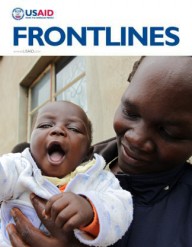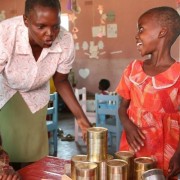 Indonesian youth hold lanterns during a candle-light vigil to mark World AIDS Day in Jakarta Dec. 1, 2009. More than 30 million people have died from AIDS, and more than 2 million are infected each year worldwide.
AFP / Adek Berry
Indonesian youth hold lanterns during a candle-light vigil to mark World AIDS Day in Jakarta Dec. 1, 2009. More than 30 million people have died from AIDS, and more than 2 million are infected each year worldwide.
AFP / Adek Berry
 Indonesian youth hold lanterns during a candle-light vigil to mark World AIDS Day in Jakarta Dec. 1, 2009. More than 30 million people have died from AIDS, and more than 2 million are infected each year worldwide.
AFP / Adek Berry
Indonesian youth hold lanterns during a candle-light vigil to mark World AIDS Day in Jakarta Dec. 1, 2009. More than 30 million people have died from AIDS, and more than 2 million are infected each year worldwide.
AFP / Adek Berry
For the first time, a microbicide has been shown to stem HIV transmission in women—news that has resonated throughout the scientific and development world.
On the day the CAPRISA trial results were unveiled at the International AIDS Conference in Vienna last month, Administrator Rajiv Shah emphasized the importance of the historic findings: “USAID is proud to be the major funder of the first-ever proof of concept that a microbicide can effectively and safely reduce the transmission of HIV from men to vulnerable women,” he said.
The trial was conducted with 889 female volunteers in Durban, South Africa, providing evidence that a 1-percent vaginal gel of the antiretroviral drug Tenofovir, when used before and after intercourse by high-risk women, reduced the risk of HIV infection by 39 percent on average. Effectiveness rose to 54 percent in women who used it 80 percent of the time. The CAPRISA 004 study, named for the Center for the AIDS Program of Research in South Africa which conducted the trial, marks the first time a woman-controlled prevention method has shown significant potential in preventing HIV transmission.
Widespread use of the gel could prevent over 1.3 million new HIV infections in South Africa alone over the next two decades, researchers estimate.
AIDS has killed more than 30 million people and continues to infect over two million a year throughout the world. With 5.7 million people infected with HIV, South Africa has higher levels than any other country.
Although researchers spent the past two decades trying to develop a microbicide gel that was effective in blocking the virus, the CAPRISA study marks the first time that a gel using an antiviral drug, which prevents the virus from multiplying, was used in trial.
The results of the study kept the conference invigorated despite activists’ concerns over perceived cutbacks on HIV/ AIDS treatment funding by the international community.
Development experts said that this trial could open the door for women in sub-Saharan Africa to assume greater control over their health. Very often, women are unable to convince partners to wear condoms, rely on their fidelity, or avoid sexual coercion and violence. Women account for about 60 percent of all infections in the world.
“First, we all recognize and understand the importance of women, and particularly, young women, bearing the brunt of the HIV epidemic in Africa,” said CAPRISA Director Dr. Salim S. Abdool Karim at a press conference. “Tenofovir gel potentially adds a new approach to HIV prevention as the first that can be used and controlled by women. It can help empower women to take control of their own risk of HIV prevention.”
In the trial, the volunteers were instructed to insert the microbicide gel up to 12 hours before having sex, again up to 12 hours afterwards, and not more than twice a day. Levels of HIV incidence in these women were compared to women who had received a placebo gel. All volunteers were provided condoms and frequent HIV-prevention counseling at the beginning of the trial and monthly thereafter.
Funding, Risks, and More Trials
Microbicide research has been a long and frustrating road for scientists and donor agencies. Jeff Spieler, a senior technical advisor for science and technology in USAID’s Bureau for Global Health, who was chief of research at the time the study began, said that USAID took a calculated risk in deciding to fund the trial.
“There were controversies,” he said, explaining that some researchers argued that there was not enough data on the antiretroviral gel to proceed. They were also concerned about the way that the gel was being used. “But ultimately, if you don’t take risks, you may not have big wins,” Spieler added.
USAID put up $16.5 million of the $18 million of the study’s costs, with the remainder of the funding provided by the South African government’s Technology Innovation Agency and CAPRISA. Technical assistance was provided by Family Health International and the product was provided by the CONRAD Program.
When the results were tallied, researchers discovered another unforeseen benefit—Tenofovir gel also protected against genital herpes (HSV-2).
“This was a huge added bonus,” said Spieler. “Protecting against HSV-2 is also critical to the prevention of HIV/AIDS.” Women with genital herpes are around 45 percent more likely to be infected with HIV if they are exposed to the virus than those who are not.
Because the CAPRISA findings will now have to be confirmed by additional trials to obtain regulatory approval, it could still be several years before this product is widely available.
“Additional studies are urgently needed to confirm and indeed to extend the findings of this trial both for safety and effectiveness,” said Dr. Karim. “Once confirmed and implemented, Tenofovir gel has the potential to alter the course of the HIV epidemic.”
USAID has vowed to be involved in a follow-up trial to CAPRISA 004, and the National Institutes of Health (NIH) currently has a trial underway using a once-a-day dosage scheme with the same gel. It expects to announce results in 2013.
In Vulindlela, the rural site for the trial, the CAPRISA team is already designing a follow-up study. CONRAD, which manufactured the prefilled applicators of Tenofovir gel for the CAPRISA study, is working with the South African government to have the product manufactured locally. Gilead Sciences, which developed the drug, had previously given a free license for the use of the gel both to CONRAD and International Partnership for Microbicides (IPM). The goal is to eventually mass produce doses that cost just 25 cents each, or to bring down costs even more by developing a way to apply the drug without an applicator.
Lee Claypool, head of USAID’s microbicide research team, said the Agency’s end goal is to make this product affordable and available for women in developing countries worldwide, especially those most vulnerable to HIV/ AIDS. “Our commitment is to get this product to the women who need it most,” he said.
Shah highlighted the CAPRISA trial as an example of USAID’s renewed focus on scientific innovation. “CAPRISA 004 is a model for future research studies in which clinical trials will be led by in-country investigators backed up by the scientific and operational expertise of their U.S. colleagues,” Shah said.
“This approach builds the research capacity of the developing world, contributes to sustainable health systems, and exemplifies how President Obama’s Global Health Initiative intends to leverage technology and innovation to improve health around the world.” .
Jessica DiRocco contributed to this story.
This article originally appeared in August 2010
What's Happened Since Then?
Following CAPRISA 004, a new public-private joint venture, known as Propreven, is preparing to obtain regulatory approvals, create manufacturing capacity, and support product distribution of tenofovir gel in various African countries. Two additional studies are also underway – the FACTS 001 clinical trial, which is a follow-on to CAPRISA 004 and is currently in year two, and the CAPRISA 008, a study that is examining and addressing implementation issues for future microbicide programs. Both of these studies are supported by a U.S. and South African partnership made up of USAID, the Bill & Melinda Gates Foundation, and the Government of South Africa.












Comment
Make a general inquiry or suggest an improvement.